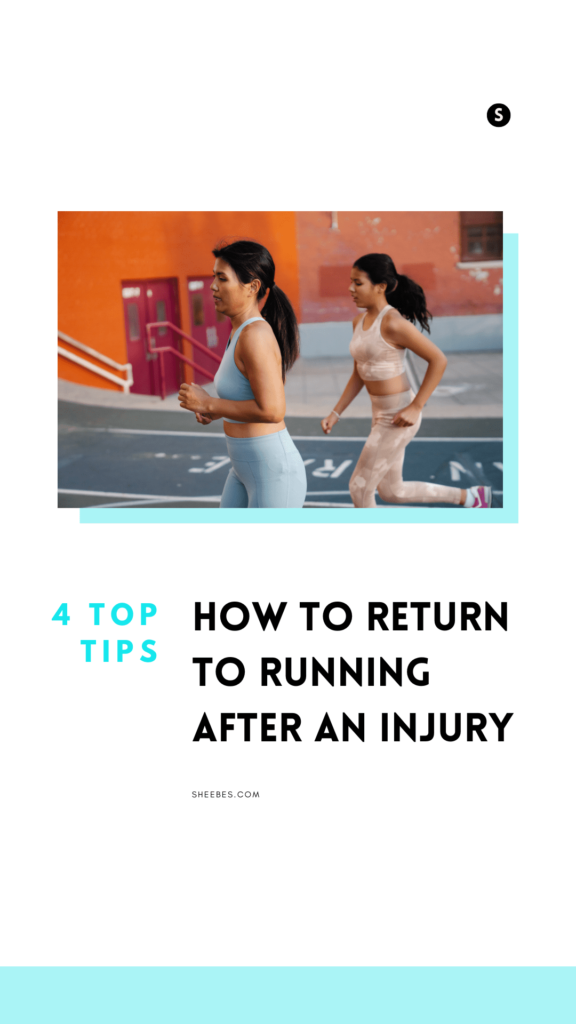Got this question? “How should I return to running after an injury?”
Should you jump right back into running? Or start from scratch?
The short answer is, that it depends on your injury and the length of time you took off from running. The longer you have been away from running, the more time you will need to ramp up your mileage to avoid reinjury.
But the good news is if you were a regular runner, you’ll regain your running fitness faster than a brand new runner.
So let’s dive in and talk about the 4 best ways you can return to running after an injury.

Whether you’re a runner looking for running tips or a cyclist searching for cycling advice, this site is here to help you elevate your fitness game.
Affiliate Disclosure: I’m here to help you grow as a rider and runner. So to keep things running smoothly and the content free, I participate in the Amazon Services program and select affiliate networks. So, when you click on those affiliate links, I earn a small commission at no extra cost to you.
HOW TO RETURN TO RUNNING AFTER INJURY

Use walk breaks to ease yourself back into running
Do you believe that, as a runner, you shouldn’t walk? If you do, you’re not alone.
But using walk breaks can help you prevent reinjury and help you run longer and faster. And if you want to get started today, the walk-run workouts in this download can help.
According to Jeff Galloway, creator of the Run-Walk-Run method, inserting walk breaks have many benefits:
- Boosts speed
- Increases endurance
- Reduce injury and fatigue
- Breaks a run into manageable chunks
“Walk breaks stop or significantly reduce the continuous buildup of stress on the weak links.
By increasing the frequency of walk breaks and shortening the length of the run segments, most of the runners I’ve coached, which have been injured, have been able to continue running as the injury healed.”
…
It’s possible to stay injury-free while continuing to increase distance with the early and regular insertion of walk breaks.
This method allows us to be in charge of our running future.”
The Run-Walk-Run Method, Jeff Galloway
For example, you might begin with treadmill walking for 30 minutes at a 3.5 miles per hour pace before progressing into running.
Once you’ve spent pain-free time walking and can walk without limping, you can then progress to easy running. 1
Still feeling some niggles? You’ll find out how to prevent common running injuries, when to stop running, and how to treat your injury here: Expert Tips to Diagnose & Prevent Common Running Injuries, The Mother Runners.

Build your mileage with easy runs to help you return to running after injury
Returning to running after an injury means you’ll have to rebuild at least some of your running fitness.
The goal at this point is to build your running volume. Your speed will return, but only after you build your foundation—running volume.
On your return to running after injury, first, you have to find your baseline.
“Your baseline is the distance you can run without pain during the run and for 48 hours after the run.
First, find your baseline on a treadmill as you have more control over speed and distance.
Run for as long as comfortable.
Stop if painful and note the distance, time and pace.
The goal is to identify a distance and speed you can do without increasing your symptoms.
When you feel comfortable on the treadmill, you can progress to a level running route outdoors.”
Running Progression Program, CU Sports Medicine, University of Colorado
It’s discouraging to take two steps back to rebuild your fitness.
But there’s hope—you’re already ahead of the game if you’ve been running for some time.
Some studies suggest that your muscles remember and retain adaptations from running.
In other words, if you have running experience, you’ll see a faster return to running than a non-runner.
But it could be helpful to keep this tip in mind: Running more mileage helps you become a more efficient runner.
In this study, runners who ran 30 miles or more had neuromuscular changes that improved their running efficiency.
Higher mileage runners did less work to cover the same distance. And, they had more spring-like behavior in their lower leg tendons, which helped propel the body forward more efficiently. 2
So the next time you’re impatient with rebuilding your running foundation, remember that building mileage—even with walk breaks—changes your muscles and tendons to help you cover the miles with less work.
In the end, more miles = less work.
After you’ve found your running baseline, then you can progress gradually by boosting your time or mileage by 10% each week. Ten percent doesn’t sound like much, but we’re applying gradual stress to your body and letting you adapt and recover to a slight boost in time and mileage

Use a guided return to running program after an injury
It can be challenging to chart your way forward when you’re coming back from an injury.
When is it okay to push through the pain? And when should you take the day off?
This is where a guided return to running program can help.
In this walk run program, you’ll find an assessment of how to gauge when to run or adjust your plan to avoid reinjury.
So by the end of this return to running training plan, you should be able to run nonstop for 30 minutes.

Keep track of your running accomplishments to keep you motivated
It can be easy to compare the amount of running and your paces to what you used to do.
And it may sound a lot like this: “I ran 3 miles today, but I used to do 6 miles easily.”
This comparison can make your return to running after an injury incredibly frustrating and discouraging.
So to combat this, consider using a ‘win’s’ list.
A ‘wins’ or running accomplishment list helps you keep track of all the things that have gone well so far on your return to running.
Anytime you need a dose of motivation and encouragement, scroll through your ‘wins’ journal to review what you’ve accomplished on your return to running.
Want to get moving? The walk-run workouts in this free download will get you running again.

Sources
- Running Progression Program, CU Sports Medicine, University of Colorado ↩
- New study reveals how high mileage running makes muscles and tendons more efficient ↩